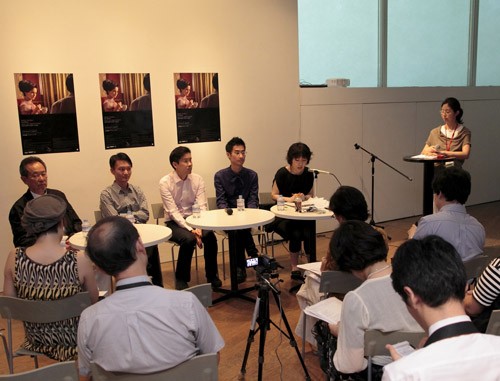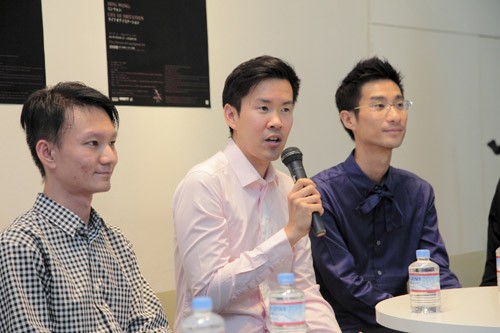From Hara Museum, Tokyo
A press conference was held on Friday, June 24 for the exhibition Ming Wong: Life of Imitation. Toshio Hara, Director of Hara Museum of Contemporary Art, greeted the guests, while Jason Toh, Senior Curator of Singapore Art Museum, delivered some remarks.

From left to right: Toshio Hara (Director, Hara Museum of Contemporary Art)、Jason Toh (Senior Curator, Singapore Art Museum), Ming Wong, Tan Fu Kuen (Guest Curator)
[Interpreter: Yumi Matsushita, MC: Masami Tsubouchi (Curator, Hara Museum)]

The artist talks about the exhibition(photos by Hirotaka Yonekura)
Ming Wong:
I have always cherished Japan as a country of great inspiration for myself. One of the things which I admire about the culture here is the ability to adopt things from elsewhere and to make it once more. This is something I try to do and I always look to Japan for inspiration. It is not just me but for example, the work I made entitled “Four Malay Stories”, which was dedicated to the work of P. Ramlee – he also got a lot of inspiration from Japanese cinemas and quoted films by Kurosawa and Ozu, for example. So this exhibition, throughout the whole preparation, drew strong connection to Japan and its film culture. And certainly, many films that were made in Singapore were inspired by Japanese films, one of the leading industry players at the time.
On a personal level, this marks the beginning of deeper research into the history of cinema and what is happening in Japan. I plan to come back and continue making work in the country.
Tan Fu Kuen:
In February 2010 I visited Tokyo and was told to visit Hara Museum. Just at the entrance of the building, I had a very good sense. I knew instantly that we had to do something here and proposed Life of Imitation. All forces came together and we were able to bring the show to Tokyo. Both of us are most pleased with this presentation at the Hara Museum because all the elements that we had put together in the Venice Pavilion have been well brought and re-created in the Hara context.
Singapore and Japan both enjoyed close relationship in terms of cinema since early 1900s. The second cinema building in Singapore was built by the Japanese. Japanese in that time was entering into South East Asia and creating mobile cinema and gradually became the first ones to build cinemas in the region. The first cinema in Bangkok was called the Japan cinema. In the period of Sun Yat Sen war time efforts, the Japanese businessmen were very enthusiastic in helping him in his efforts by sponsoring films or screening films at Sun Yat Sen villa in Singapore. Ozu himself was attached to the film units in Singapore during the Japanese colonial years and this is where he was able to view many American films. That also influences his esthetics after. Our own cinematic icon P Ramlee was growing up in Penang next to the Japan school and learnt Japanese and was exposed to Japanese films — everyday esthetics of Ozu sinked into his practice so he was able to make films that were representations of everyday life and behavior, capturing the atmosphere and behaviors of 1950s and 60s of his community. In that way I would like to see that Life of Imitation at the Hara Museum is yet another mark of this relationship between the two countries.
(to be continued)
—————————————————
Please check here for Hara Museum access information
Ming Wong: Life of Imitation
-August 28, Sun
Now on sale. Yoshitmo Nara Charity Large-sized Postcard Set
Hara Museum is now participating in MuPon (museum discount ticket system using iPhone application)! http://www.tokyoartbeat.com/apps/mupon
Visit Hara Museum Twitter (in Japanese only) (account name: @haramuseum)
http://twitter.com/haramuseum
http://www.haramuseum.or.jp (museum website)
http://mobile.haramuseum.or.jp (mobile site)
There has been temporary changes(until July 22) in museum opening hours for Hara Museum ARC (Gunma). Please click here for further details.
